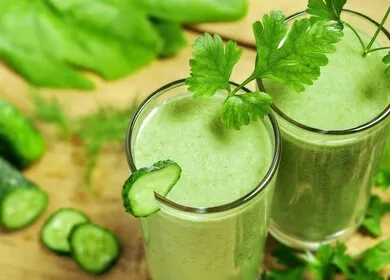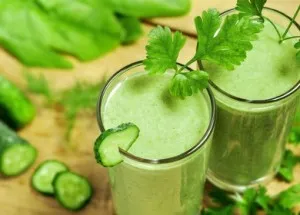
- Share on Facebook117
- Share on Pinterest
- Share on Twitter
We are avid juicers here at The Alternative Daily, and we are blend-heads as well. Both are promised to be the answer to optimal health by many. Although both smoothies and juices offer nutritional benefits, is one really better than the other? Here is a look of some of the advantages of each.
Benefits of Juicing
With few Americans getting the recommended daily amounts of fruits and vegetables, juicing is a convenient way to meet these goals and supply the body with the vitamins and minerals it needs to perform optimally. According to the Harvard School of Health, the average American gets only three servings of fruits and vegetables per day.
Because it takes quite a few veggies or fruits to make just an ounce of juice, by juicing, you’ll likely get lots more of those nutrient-dense foods. Many people have an aversion to eating produce; juicing provides an easier way to get in the daily required limit. It also allows for consumption of a wider variety of fruits and veggies. As a result, nutritional needs are more likely to be covered.
The Dr. Sears Wellness Institute and a number of other proponents also believe that the process of juicing makes the nutrients more readily available for use in the body. The fact that food is already broken down makes it much easier on the digestive system and requires less energy.
The high concentration of nutrients super-charges the body with phytonutrients, helping to battle disease and degenerative illness while providing an energy boost. Antioxidants combat the damaging effects of free radicals and can slow the aging process. Other noted benefits of juicing include liver detoxification, improved mental clarity and a reduction in symptoms of depression.
Keep in mind – juicing strips away much of the fiber content of fruits and vegetables, so you’ll still need to meet this need from other foods in your diet.
Benefits of Smoothies
 One of the advantages of smoothies is that they don’t require any expensive equipment. All it takes is an ordinary blender – juicers can be rather costly. By adding protein, it’s easy to make a smoothie that provides a balanced and nutritious meal.
One of the advantages of smoothies is that they don’t require any expensive equipment. All it takes is an ordinary blender – juicers can be rather costly. By adding protein, it’s easy to make a smoothie that provides a balanced and nutritious meal.
Because smoothies contain fiber, calories are slowly absorbed. This helps to keep sugar levels balanced and staves off hunger pangs by keeping you fuller longer. The fiber also works to promote better digestion as it helps to push waste material along the digestive tract while promoting healthy bacteria.
While you may not receive the high, potent nutrition you would with juice, you’ll still receive the antioxidants, vitamins and minerals from any fruits or vegetables you include in your drink.
Make your smoothie a good source of protein by adding things like almond milk, organic yogurt or whey protein powder. Give your blend a heart-healthy omega-3 fatty acid kick by throwing in chia seeds or flaxseeds. A tablespoon of organic coconut oil will supply your healthy saturated fat needs and push your body to burn more fat. If you need more liquid, try adding 100% pure coconut water.
Both juicing and blending offer a plethora of health benefits. Just be sure that you are blending and juicing the healthiest ingredients possible.
Choose what works best for you and enjoy!
-The Alternative Daily
- Share on Facebook117
- Share on Pinterest
- Share on Twitter

